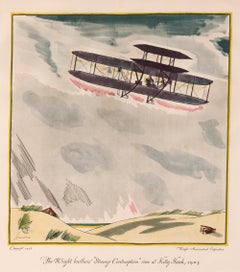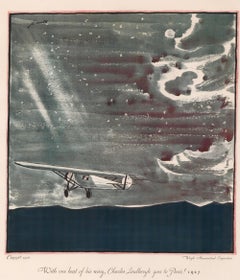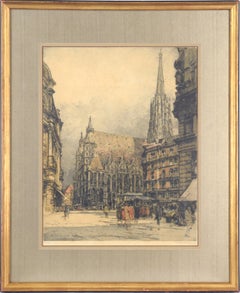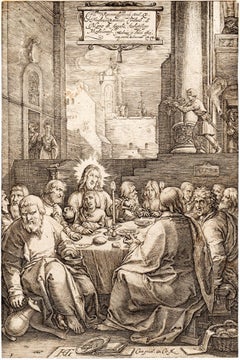Frank Lemon Art
to
2
Overall Width
to
Overall Height
to
2
2
2
2
2
2
1
1
2
3
10,025
2,756
1,379
1,375
2
Artist: Frank Lemon
The Wright Brothers at Kitty Hawk
By Frank Lemon
Located in New York, NY
Lemon, Frank.
Flights: Unforgettable Exploits of the Air.
This plate: With one beat of his wing, Charles Lindbergh goes to Paris! 1927.
Wright Aeronautical Corporation, 1928.
Origi...
Category
1920s Frank Lemon Art
Materials
Paper
Charles Lindbergh Over Paris
By Frank Lemon
Located in New York, NY
Lemon, Frank.
Flights: Unforgettable Exploits of the Air.
This plate: With one beat of his wing, Charles Lindbergh goes to Paris! 1927.
Wright Aeron...
Category
1920s Frank Lemon Art
Materials
Paper
Related Items
St. Stephen's Cathedral in Vienna - Hand Colored Cityscape Lithograph
By Luigi Kasimir
Located in Soquel, CA
Detailed and dramatic hand-colored etching by Luigi Kasimir (Austrian, 1881-1962). St. Stephen's cathedral towers above the streets of Vienna, with people going about their daily bus...
Category
1920s Photorealist Frank Lemon Art
Materials
Paper, Watercolor, Lithograph
$1,120 Sale Price
20% Off
H 29.75 in W 23.75 in D 0.75 in
The Last Supper, from The Passion of Christ
By Hendrick Goltzius
Located in Middletown, NY
Engraving on cream laid paper, 8 x 5 3/8 inches (203 x 137 mm), trimmed at the platemark. A fine impression with a Coat of Arms watermark. Second state, after the addition of the Frederick de Witt...
Category
16th Century Old Masters Frank Lemon Art
Materials
Laid Paper, Engraving
New York Skyline, NY; East River
By Leon Dolice
Located in Middletown, NY
Etching on medium stock, cream wove paper, 5 15/16 x 10 3/16 inches (151 x 259 mm), full margins. Signed and titled in pencil, lower margin. A fine and detailed impression in dark bl...
Category
1930s American Modern Frank Lemon Art
Materials
Archival Paper, Etching
Communipaw, NY; January Thaw
By Thomas Moran
Located in Middletown, NY
A delicate composition of an industrial Hudson River town, seen from lower Manhattan; a view of what is now Liberty State Park.
New York: 1884. Etching with aquatint on cream laid p...
Category
Late 19th Century Realist Frank Lemon Art
Materials
Laid Paper, Etching, Aquatint
Passaic Meadows (In the Newark Meadows)
By Thomas Moran
Located in Middletown, NY
Boston: American Art Review, 1880. Etching on cream laid paper, 5 3/4 x 8 3/4 inches (146 x 230mm), full margins. Light uniform age tone, scattered handling creases and minor toning ...
Category
Late 19th Century Realist Frank Lemon Art
Materials
Laid Paper, Etching
'View of Nissaka', After Utagawa Hiroshige 歌川廣重, Ukiyo-e Woodblock, Tokaido
By Utagawa Hiroshige (Ando Hiroshige)
Located in Santa Cruz, CA
An ink on paper, Nishiki-e and Yoko-e woodblock landscape showing travelers moving through Sayo Mountain Pass. Signed in Kanji upper left, "Hiroshige Ga" for Utagawa (Ando) Hiroshige...
Category
Mid-20th Century Frank Lemon Art
Materials
Sumi Ink, Washi Paper
"Untitled No.16" From "The Yosemite Suite" By David Hockney
By David Hockney
Located in Dubai, Dubai
"Untitled No.16" From "The Yosemite Suite"
By David Hockney
David Hockney, a prominent British artist, is celebrated for his versatile and innovative contributions to 20th-century ...
Category
2010s Contemporary Frank Lemon Art
Materials
Paper, Inkjet
$209,428
H 37.01 in W 27.96 in
Victorian Engraving Forest with Fairies and a Mounted Knight Original Gilt Frame
Located in Rochester, NY
Forest fantasy scene. Steel etching. Original beautiful gold leaf frame. Not signed.
Category
19th Century Frank Lemon Art
Materials
Paper
$295
H 14 in W 12 in D 1 in
Le Ruisseau Dans La Clairière (The Brook in the Clearing)
By Charles François Daubigny
Located in Middletown, NY
Paris: 1862. Cliché-verre on lightweight photosensitive wove paper, 8 3/4 x 7 1/8 inches (220 x 180 mm) (sheet), full margins. Signed in the plate, lower right. Because this impressi...
Category
Mid-19th Century Realist Frank Lemon Art
Materials
Photographic Paper
$1,500
H 8.75 in W 7.125 in
Tropical Botanical Cyanotype, Marrakesh Majorelle Palm, Blue Tree, Still Life
By Kind of Cyan
Located in Barcelona, ES
This is an exclusive handprinted limited edition cyanotype.
This cyanotype shows a palm tree from the Majorelle Gardens in Marrakesh.
Details:
+ Title: Marrakesh Majorelle Palm
+ Y...
Category
2010s Naturalistic Frank Lemon Art
Materials
Watercolor, Other Medium, Paper, Monotype
Old Houses, Byres Road, Partick (Scotland)
By Sir David Young Cameron, R.A.
Located in Middletown, NY
Glasgow: Regality Club, 1894. Etching on cream laid paper with a poppy watermark, 4 1/2 x 5 7/8 inches (115 x 148 mm) full margins. Notations in the margins recto, well outside of image area. Scattered very minor light brown foxing in the right-side sheet quadant, virtually invisible on recto.
[Rinder 191].
The son of a clergyman, Sir David Young Cameron was born in Glasgow in 1865. After a brief and unhappy dalliance in the fields of business and law, Cameron began attending the prestigious Glasgow School of the Arts in 1881, and later the Edinburgh School of the Arts. At first associated with the Glasgow Boys (John Lavery, Joseph Crawhall...
Category
Early 1900s Modern Frank Lemon Art
Materials
Laid Paper, Etching
$300
H 4.5 in W 5.875 in
Arcadian riverscape with different figures by a tree [Arcadisch rivierlandschap]
Located in Middletown, NY
A beautiful Arcadian landscape after Johannes Glauber.
Amsterdam: 1721.
Etching on handmade laid paper with an intact fleur-de-lis watermark. 203 x 275 mm; 8 x 10 7/8 inches, trimm...
Category
18th Century Old Masters Frank Lemon Art
Materials
Handmade Paper, Laid Paper, Etching
Frank Lemon art for sale on 1stDibs.
Find a wide variety of authentic Frank Lemon art available for sale on 1stDibs. You can also browse by medium to find art by Frank Lemon in paper and more. Not every interior allows for large Frank Lemon art, so small editions measuring 17 inches across are available. Frank Lemon art prices can differ depending upon medium, time period and other attributes. On 1stDibs, the price for these items starts at $525 and tops out at $525, while the average work can sell for $525.



